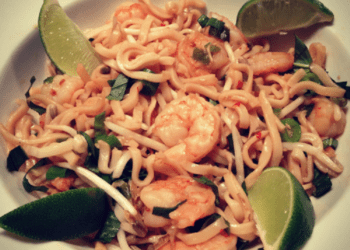There’s something wonderfully comforting about stir-fried noodles, and for me, Pad Thai tops the list. It’s one of those dishes that always hits the spot – a little sweet, a bit tangy, slightly salty, and packed with just the right amount of crunch and chew. If you’ve ever had a plate of Pad Thai, you’ll know what I mean. And if you haven’t, well, you’re in for a real treat.
Pad Thai is one of Thailand’s most beloved street foods. It’s quick to cook, colourful on the plate, and full of flavour. The beauty of it lies in the balance. Thai cooking is all about harmony, and Pad Thai captures that perfectly in one dish.
Let’s talk about the ingredients. The base of the dish is rice noodles – flat, thin noodles that soak up flavour like a sponge. They’re soft and slippery, but not mushy, giving the dish its signature texture. A key ingredient is tamarind paste. It adds that unmistakable tangy kick that lifts the whole thing. Tamarind might seem unusual if you’ve never cooked with it, but it’s really what gives Pad Thai its character.
Next up, we’ve got fish sauce – strong stuff on its own, but when mixed in, it deepens the savoury side of the dish. It’s the saltiness that doesn’t just season the food but adds umami, that wonderful, mouth-filling richness. Sugar is in there too – usually palm sugar – which balances out the tang and salt. It’s all about keeping those flavours in check.
Crushed peanuts bring the crunch. You might think they’re just a topping, but they actually give a lovely contrast to the soft noodles and juicy protein. Speaking of which, Pad Thai can be made with prawns, chicken, tofu, or even a mix. Prawns are especially popular, giving a slightly sweet and briny note that works beautifully with the other ingredients.
Then there’s the egg – scrambled into the noodles as they cook – adding a bit of creaminess and body. And of course, we can’t forget the beansprouts and spring onions. They’re tossed in right at the end to stay crisp and fresh, and they really lighten the whole dish. A wedge of lime on the side is a must – a final squeeze over the top just before eating brings all the flavours to life.
Pad Thai is one of those dishes that always feels like a little celebration. Whether you’re making it at home or ordering it from a local takeaway, there’s something special about that tangle of noodles and flavours. It’s not just food – it’s a warm, delicious comfort bowl.

Pad Thai
Ingredients
- 12 oz thin rice noodles
- 3 tbsp peanut oil or vegetable
- 4 cloves garlic finely chopped
- 1 cup shrimp peeled roughly chopped
- 2 large eggs free range lightly beaten
- 3 tbsp fish sauce
- 1 tbsp sugar
- 2 cups mung bean sprouts
- 2 large scallions sliced
- 1/4 cup roasted salted peanuts finely chopped
- 1/4 bunch cilantro chopped
- 3 whole limes wedges
- crushed red pepper flakes to taste
Instructions
- Soak the noodles in enough water to cover generously for 1 hour.12 oz thin rice noodles
- Drain thoroughly and toss with half the oil.3 tbsp peanut oil
- Heat the remaining oil in a wok or large, non-stick skillet over high heat until the oil is almost smoking.
- Add the garlic and cook for 30 seconds.4 cloves garlic
- Add the shrimp and cook 30 seconds.1 cup shrimp
- Add the eggs and let sit for 10 to 15 seconds, until they begin to set.2 large eggs
- Stir to break up any large lumps. Add the fish sauce, sugar, and the drained noodles and stir to combine.3 tbsp fish sauce, 1 tbsp sugar
- Add the bean sprouts and green onion, reserving some of each for garnish, and stir to combine. Transfer to a serving platter.2 cups mung bean sprouts, 2 large scallions
- Garnish with the reserved bean sprouts and green onion, chopped peanuts, red pepper flakes, cilantro, and lime wedges.1/4 cup roasted salted peanuts, 1/4 bunch cilantro, crushed red pepper flakes, 3 whole limes
